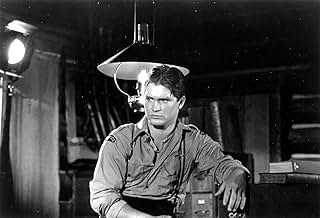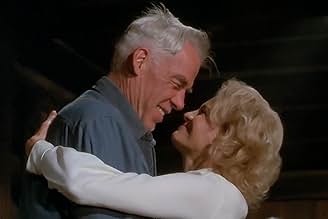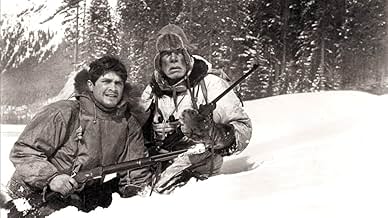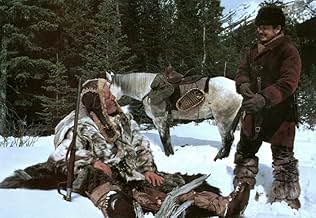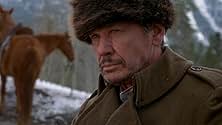NOTE IMDb
6,9/10
8,8 k
MA NOTE
En 1931, au Canada, le trappeur yukonnais Johnson a une querelle avec un propriétaire de chien.En 1931, au Canada, le trappeur yukonnais Johnson a une querelle avec un propriétaire de chien.En 1931, au Canada, le trappeur yukonnais Johnson a une querelle avec un propriétaire de chien.
- Réalisation
- Scénario
- Casting principal
Richard Davalos
- Beeler
- (as Dick Davalos)
Avis à la une
I had fond memories of watching Death Hunt as a teenager and I thought it would be worth revisiting.
Charles Bronson plays, Albert Johnson, a solitary trapper who becomes the target of revenge after rescuing a dog from a cruel fight. He also slaps some manners into the owner in the process.
Feeling emasculated and weakened the man gets a gang together and turns up at Albert's cabin to teach him a lesson. A gunfight ensues, and in one of the men gets a belly full of lead. Sgt. Edgar Millen, played by Lee Marvin, of the Mounty police has the grim task of cleaning up the mess and bringing order. He takes one look at the situation and can see that it was the fault of trigger-happy hotheads, but with one man dead he has no choice but to Albert in. It's the law.
He refuses, of course, and it kickstarts a chain of events that leads them on a chase across the snow-covered mountains of Yukon in Northern Canada. Things get out of hand when a bet in a local tavern has every gun-toting buffoon in the county joining the posse.
Watching Death Hunt it's hard not to think of First Blood or The Fugitive. You'll find elements of both here. Made in 1981 this is without doubt one of last great Charles Bronson movies. It's also, given the fact that he only has three lines dialogue, one of his best performances. Lee Marvin is a commanding presence, as ever, but looks tired. Those years of boozing and smoking have obviously caught up with him. Then there's Angie Dickensian, playing the part of the only woman in the movie and I think that's the only reason she was there.
While this is based on a true story, all signs indicate that this was a very, very loose interpretation of the events of the real Albert Johnson.
Charles Bronson plays, Albert Johnson, a solitary trapper who becomes the target of revenge after rescuing a dog from a cruel fight. He also slaps some manners into the owner in the process.
Feeling emasculated and weakened the man gets a gang together and turns up at Albert's cabin to teach him a lesson. A gunfight ensues, and in one of the men gets a belly full of lead. Sgt. Edgar Millen, played by Lee Marvin, of the Mounty police has the grim task of cleaning up the mess and bringing order. He takes one look at the situation and can see that it was the fault of trigger-happy hotheads, but with one man dead he has no choice but to Albert in. It's the law.
He refuses, of course, and it kickstarts a chain of events that leads them on a chase across the snow-covered mountains of Yukon in Northern Canada. Things get out of hand when a bet in a local tavern has every gun-toting buffoon in the county joining the posse.
Watching Death Hunt it's hard not to think of First Blood or The Fugitive. You'll find elements of both here. Made in 1981 this is without doubt one of last great Charles Bronson movies. It's also, given the fact that he only has three lines dialogue, one of his best performances. Lee Marvin is a commanding presence, as ever, but looks tired. Those years of boozing and smoking have obviously caught up with him. Then there's Angie Dickensian, playing the part of the only woman in the movie and I think that's the only reason she was there.
While this is based on a true story, all signs indicate that this was a very, very loose interpretation of the events of the real Albert Johnson.
With a lurid title like "Death Hunt" and lead actors like Charles Bronson and Lee Marvin, it would be easy to dismiss this film as just another shoot-'em-up run through the mill to capitalize on the marquee names (particularly Bronson). To do so, however, would be to overlook a well-made gem of an adventure film.
The problem, of course, with most films of this ilk is that they offer a minimum set-up and characters and then set the guns a-blazin'. Not so here. The premise is established well, with Bronson as the noble loner and Marvin as the gruff, weary Canadian Mountie. The themes and plot devices are familiar, to be sure - the sense of honor, the anti-hero, the wet behind the ears rookie lawman, even a little bit of a love story.
I had seen most of this film on cable and thought I understood it. Recently I rented it so I could finally see the first half hour and my feelings about it changed. Seeing the film from start to finish, I realized I had misjudged the intentions of the Marvin character. I thought the character was just another "honorable to the point of dishonorable" hero, when in fact he's a conflicted man. During the film, you can see that he knows he's as much responsible for what has happened, and he's not so much interested in "doing the right thing" as he is in covering his own rear end.
I was surprised to see in the beginning that the film is set in 1931; it seems much like a Western. But then you realize that this was still a very isolated area and that, unlike the southwest, civilization hadn't quite caught up with this part of the world yet - particularly with lawmen like Marvin on duty.
"Death Hunt" delivers all the goods. There is plenty of action and excitement, yet also a lot of substance as the story unfolds. It's a notch above most films of its kind. I enjoyed it so much that I'm considering adding it to my own DVD library, and I'd also like to learn more about the real story that it is based on.
The problem, of course, with most films of this ilk is that they offer a minimum set-up and characters and then set the guns a-blazin'. Not so here. The premise is established well, with Bronson as the noble loner and Marvin as the gruff, weary Canadian Mountie. The themes and plot devices are familiar, to be sure - the sense of honor, the anti-hero, the wet behind the ears rookie lawman, even a little bit of a love story.
I had seen most of this film on cable and thought I understood it. Recently I rented it so I could finally see the first half hour and my feelings about it changed. Seeing the film from start to finish, I realized I had misjudged the intentions of the Marvin character. I thought the character was just another "honorable to the point of dishonorable" hero, when in fact he's a conflicted man. During the film, you can see that he knows he's as much responsible for what has happened, and he's not so much interested in "doing the right thing" as he is in covering his own rear end.
I was surprised to see in the beginning that the film is set in 1931; it seems much like a Western. But then you realize that this was still a very isolated area and that, unlike the southwest, civilization hadn't quite caught up with this part of the world yet - particularly with lawmen like Marvin on duty.
"Death Hunt" delivers all the goods. There is plenty of action and excitement, yet also a lot of substance as the story unfolds. It's a notch above most films of its kind. I enjoyed it so much that I'm considering adding it to my own DVD library, and I'd also like to learn more about the real story that it is based on.
Charles Bronson has less than fifty words of dialogue in this film, since he spends most of it running through the snow on his own pursued by the mounties, but it is still one of his better films from the late seventies and early eighties era.
He plays the real life character Albert Johnson, a fur trapper who killed some people in a dispute over dogs and went on the run in territory which had never been crossed during the ferocious Arctic winter. He successfully got away from them, despite the fact that they had many men, dogs and even an aeroplane to help them to track him down.
This movie version is simple blood and thunder stuff, with a starry cast, some strong language and a handful of sparkling action sequences. It has weak points too, such as the wasted character played by Angie Dickinson, and a few slow patches in terms of pacing. However, when you think that Bronson was mainly working on such dross as The Evil That Men Do, Death Wish II, and Ten to Midnight at this point in his career, this is at least a slightly above-average film worthy of his rugged talents.
He plays the real life character Albert Johnson, a fur trapper who killed some people in a dispute over dogs and went on the run in territory which had never been crossed during the ferocious Arctic winter. He successfully got away from them, despite the fact that they had many men, dogs and even an aeroplane to help them to track him down.
This movie version is simple blood and thunder stuff, with a starry cast, some strong language and a handful of sparkling action sequences. It has weak points too, such as the wasted character played by Angie Dickinson, and a few slow patches in terms of pacing. However, when you think that Bronson was mainly working on such dross as The Evil That Men Do, Death Wish II, and Ten to Midnight at this point in his career, this is at least a slightly above-average film worthy of his rugged talents.
I have always been intrigued by this film, mostly because of the fantasy it suggests, and even obtained a VHS copy to look it over more closely. Using the leads posted by other readers, I have been able to glean the following facts from various Internet and library resources concerning the strange tale of The Mad Trapper of Rat River, played in Death Hunt by Charles Bronson;
a] A man referring to himself as Albert Johnson [identified post mortem by associates as Albert Nelson, although that was also an assumed name] arrived in the Aklavik area and brought attention onto himself from a large purchase of ammunition, a new shotgun, and an inexplicable refusal to get himself a trapper's license. Johnson ran afoul of a Constable Edgar Millen [Lee Marvin's character] during the New Years season of 1931-32 after his apparent meddlings with the traps of some of the local types, who suggested that he had gone bonkers in the isolation of the mountains.
b] Two posses did in fact make seperate trips to Johnson's handmade cabin [measuring 8 feet by 8 feet] and one of the Mounties did in fact have a brief encounter with Johnson through an open window; The first time he simply wouldn't answer their knocks, and the second time he shot a Mountie through his closed door with a .38 automatic. A third posse, with Const. Millens, then made the 80 mile dogsled trip and blew up Johnson's cabin after he again refused to acknowledge them.
c] After they blew up his cabin, Johnson did indeed jump up out of a foxhole he had been hiding in, firing a sawed off shotgun and a .22 repeater with the stock removed. The Mounties retreated, and Johnson slipped away in the darkness.
d] A resulting "death hunt" did indeed ensue, set entirely above the arctic circle, and by the first-time ever use of wireless radios by law enforcement, kept the public of Canada and America riveted with their newspaper and wire reports of the two week long manhunt that was the O.J. Simpson crime case of it's day.
Johnson proved a remarkable adversary, using every trick in the book to confound his pursuers, and managed to survive the nightly -40 tempetures with little or no supplies or survival gear. They did manage to corner him on one occasion; there was a gunfight, Constable Millens was killed, and Johnson escaped by climbing a sheer cliff with his bare hands in the dead of night during a blizzard.
e] A bush pilot and former WW1 air ace became involved in the pursuit, not only by resupplying the posse and flying out wounded men, but played an invaluable role in tracking Johnson after he had made his initial escape, using another wireless radio to vector in the ground pursuit in another law enforcement first. He damn near well almost escaped too, though he was finally cut down in a hail of lead after keeping the authorities at bay for 48 days.
f] The whole case was dubbed "The Mad Trapper of Rat River" incident by the press owing to the locals' contention that Johnson had gone cabin happy. He was found to be carrying a $2400 bankroll when searched, and I have found two references to "gold teeth" or gold fillings; The natives of the area had a fable about "The Trapper who steals the gold from men's teeth" that may have been attributed to Johnson after he was found to have some gold dental work in his posession.
Whether they were his or someone else's is unknown, but their presence plus all that cash led to a rumor that he got rich by prying folks' gold fillings out. This has never been substantiated, and the "Mad Trapper" name was pinned to him before these revelations came to light. To this very day, Johnson's actual identity remains a complete mystery, and his bid for freedom one of the most remarkable examples of man surviving the elements.
NOW, with that in mind, Death Hunt's scriptwriters took a few liberties with the facts to create a more romanticized tale;
- The conflict with the locals is initiated by having Bronson break up a dog fight, making his character sympathetic when compared to the dirt bags who pick a scrap with him afterwards.
- William Beckamn's character of Old Bill is introduced to provide a way for Bronson's character to survive the film after Lee Marvin manages to blow Bill's face off with a single slug. Nice shootin'.
- Lee Marvin's Sgt. Millens also survives and is credited with the man who killed Albert Johnson. Maybe the producers though this was a way of paying homage to Millen's memory.
- The pilot is turned into a jerk to create a "new world vs. old values" conflict with Marvin, then provided with a machine gun equipped biplane to he can gun down Apollo Creed and reinforce the senselessness of it all. The actual pilot. a Capt. "Wop" May, was widely regarded as a hero for the role he played.
- The film was shot during the spring and summer thaw so that characters could wander around in open jackets and sweaters. Much of the pursuing posse footage looks like it was filmed on a snowed over golf course somewhere; we never get a feel that these men are actually battling against the elements.
- The one scene that Bronson and Marvin share is so strangely shot and edited as to suggest that the two actors were not on the set at the same time. Watch it closely -- you can never see both men's faces in the same shot.
Yet I will always have a soft spot for Death Hunt -- it is probably the first R rated film I ever saw. It would be interesting to see a more historically accurate account of the Mad Trapper comitted to film; think of this as the fanciful and romanticized version.
If you have ever dreamed of taking a pack of supplies, a rifle and a dog up into the mountains and saying To Hell With Civilization, this film was made for you.
a] A man referring to himself as Albert Johnson [identified post mortem by associates as Albert Nelson, although that was also an assumed name] arrived in the Aklavik area and brought attention onto himself from a large purchase of ammunition, a new shotgun, and an inexplicable refusal to get himself a trapper's license. Johnson ran afoul of a Constable Edgar Millen [Lee Marvin's character] during the New Years season of 1931-32 after his apparent meddlings with the traps of some of the local types, who suggested that he had gone bonkers in the isolation of the mountains.
b] Two posses did in fact make seperate trips to Johnson's handmade cabin [measuring 8 feet by 8 feet] and one of the Mounties did in fact have a brief encounter with Johnson through an open window; The first time he simply wouldn't answer their knocks, and the second time he shot a Mountie through his closed door with a .38 automatic. A third posse, with Const. Millens, then made the 80 mile dogsled trip and blew up Johnson's cabin after he again refused to acknowledge them.
c] After they blew up his cabin, Johnson did indeed jump up out of a foxhole he had been hiding in, firing a sawed off shotgun and a .22 repeater with the stock removed. The Mounties retreated, and Johnson slipped away in the darkness.
d] A resulting "death hunt" did indeed ensue, set entirely above the arctic circle, and by the first-time ever use of wireless radios by law enforcement, kept the public of Canada and America riveted with their newspaper and wire reports of the two week long manhunt that was the O.J. Simpson crime case of it's day.
Johnson proved a remarkable adversary, using every trick in the book to confound his pursuers, and managed to survive the nightly -40 tempetures with little or no supplies or survival gear. They did manage to corner him on one occasion; there was a gunfight, Constable Millens was killed, and Johnson escaped by climbing a sheer cliff with his bare hands in the dead of night during a blizzard.
e] A bush pilot and former WW1 air ace became involved in the pursuit, not only by resupplying the posse and flying out wounded men, but played an invaluable role in tracking Johnson after he had made his initial escape, using another wireless radio to vector in the ground pursuit in another law enforcement first. He damn near well almost escaped too, though he was finally cut down in a hail of lead after keeping the authorities at bay for 48 days.
f] The whole case was dubbed "The Mad Trapper of Rat River" incident by the press owing to the locals' contention that Johnson had gone cabin happy. He was found to be carrying a $2400 bankroll when searched, and I have found two references to "gold teeth" or gold fillings; The natives of the area had a fable about "The Trapper who steals the gold from men's teeth" that may have been attributed to Johnson after he was found to have some gold dental work in his posession.
Whether they were his or someone else's is unknown, but their presence plus all that cash led to a rumor that he got rich by prying folks' gold fillings out. This has never been substantiated, and the "Mad Trapper" name was pinned to him before these revelations came to light. To this very day, Johnson's actual identity remains a complete mystery, and his bid for freedom one of the most remarkable examples of man surviving the elements.
NOW, with that in mind, Death Hunt's scriptwriters took a few liberties with the facts to create a more romanticized tale;
- Bronson's Abert Johnson is now a decoarted war veteran trained in Special Ops, which accounts for his hardiness, comfort with weapons and wealth of survival skills.
- The conflict with the locals is initiated by having Bronson break up a dog fight, making his character sympathetic when compared to the dirt bags who pick a scrap with him afterwards.
- The dog is then killed to provide Bronson with an understandable motive to blow someone's head off and escalate the confrontation. Poor doggie...
- William Beckamn's character of Old Bill is introduced to provide a way for Bronson's character to survive the film after Lee Marvin manages to blow Bill's face off with a single slug. Nice shootin'.
- Lee Marvin's Sgt. Millens also survives and is credited with the man who killed Albert Johnson. Maybe the producers though this was a way of paying homage to Millen's memory.
- The pilot is turned into a jerk to create a "new world vs. old values" conflict with Marvin, then provided with a machine gun equipped biplane to he can gun down Apollo Creed and reinforce the senselessness of it all. The actual pilot. a Capt. "Wop" May, was widely regarded as a hero for the role he played.
- The film was shot during the spring and summer thaw so that characters could wander around in open jackets and sweaters. Much of the pursuing posse footage looks like it was filmed on a snowed over golf course somewhere; we never get a feel that these men are actually battling against the elements.
- The one scene that Bronson and Marvin share is so strangely shot and edited as to suggest that the two actors were not on the set at the same time. Watch it closely -- you can never see both men's faces in the same shot.
Yet I will always have a soft spot for Death Hunt -- it is probably the first R rated film I ever saw. It would be interesting to see a more historically accurate account of the Mad Trapper comitted to film; think of this as the fanciful and romanticized version.
If you have ever dreamed of taking a pack of supplies, a rifle and a dog up into the mountains and saying To Hell With Civilization, this film was made for you.
Here is a story set in Canada about Canadians and yet it was made by the US. I have to ponder why Canada didn't jump on doing this story themselves. If one wonders why Canadian movies are so lame (about failure, disease, depression, weird humor) I would say it is because culturally we have an aversion to examining ourselves in a critical fashion whereas other countries do it quite naturally. England has made films about notorious murders, same with Australia, or Germany (Tenderness of the Wolves), and of course, the US. This story would have been perfect material for a domestic movie--but I can find no evidence that Canada ever sought to make this story themselves. I can understand with the stars involved that they dramatized it and changed the facts, but if it were done with no stars, and kept to the historical story, it still would have been fascinating. But the government film funding bodies don't like stories that present Canada in a negative light. At least in the English side-I know Quebec has covered stories on its history in fictional fashion. I remember the furor over a Canadian murder case when a Canadian producer wanted to make a film about it and was harshly condemned, so the US made it-and Canadian crew people vowed not to work on it. This is seriously screwed up thinking. If Canada wants to develop a normal film industry it needs to be less reserved and more self-examining.... On the film itself, I agree with the sentiments that you wouldn't see this film made today-and if you did, it would star model-types. Character actors have really gone extinct. Some of the melodramatic touches in the film worked for me (the dog, the trapper Bill), others fell flat(the inserted love story). Still, Bronson was effective (you could totally believe he was a rugged mountain man) and Marvin had some good lines (I am sure Canadian government culture ministers would have axed his comment calling the trappers "savages" if it was made in country).
Le saviez-vous
- AnecdotesCharles Bronson once said of his Albert Johnson character in this movie: "There are two schools of thought about the characters . . . Some believe the man [Albert Johnson] was a criminal. Others believe, as I do, that he was innocent of any wrongdoing. We decided to show him as a man who was a victim of someone else's need to perform violence. In trying to protect himself against an unprovoked attack, he was forced to kill one of his assailants."
- GaffesWhile Albert Johnson is making his escape through the forest, a modern highway guardrail appears clearly in the background. These guardrails were not in use during the time of this story, and Johnson was supposed to be out in the wilderness.
- Citations
Constable Alvin Adams: Well, I just figure any man who risks his neck to save a dog's life isn't going to kill someone for gold teeth.
Meilleurs choix
Connectez-vous pour évaluer et suivre la liste de favoris afin de recevoir des recommandations personnalisées
- How long is Death Hunt?Alimenté par Alexa
Détails
Box-office
- Budget
- 10 000 000 $US (estimé)
Contribuer à cette page
Suggérer une modification ou ajouter du contenu manquant

Lacune principale
What is the Canadian French language plot outline for Chasse à mort (1981)?
Répondre


